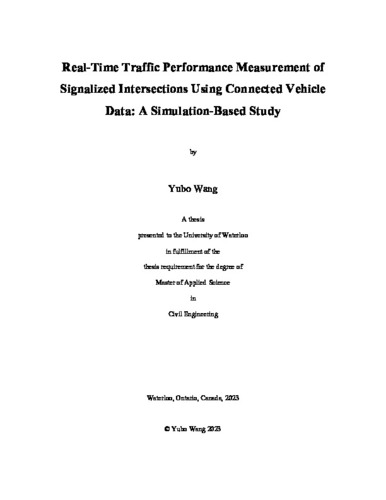| dc.description.abstract | Traffic congestion has long become a major concern in many cities in Canada and around the world. It has been estimated that the annual total economic loss due to traffic congestion in major Canadian urban centers has reached nearly $4 billion. Real-time monitoring of traffic conditions and measurement of the performance of the underlying traffic management systems is a critical requirement for mitigating and minimizing the impact of traffic congestion in an urban road network. The latest advance in the Connected Vehicle (CV) technology has afforded a new opportunity for developing solutions that make use of high-resolution trajectory data for real-time urban traffic monitoring and performance measurement, such as Automated Traffic Signal Performance Measures (ATSPM). However, many critical issues still need to be addressed before the potential of CV can be fully realized. For example, in the context of ATSPM, what traffic performance measures could be derived from the CV data? Can non-recurrent congestion be detected in real-time and at what latency? What would be the optimal spatial and temporal data aggregation resolutions of CV data? What would be the effect of the CV market penetration rate on the reliability of specific performance measures? This research attempts to address some of these questions through a simulation study of a real-world signalized urban arterial corridor from Broward County, Florida, US, consisting of 17 signalized intersections with a wide range of layouts and congestion levels. An extensive set of simulation experiments have been conducted under a range of scenarios varying by facility types (single intersection vs. corridor), congestion level (from undersaturated to oversaturated), CV market penetration rates (1%-25%), and signal timing plans. Under each scenario, samples of vehicles at specific market penetration rates are randomly drawn from the simulated traffic population to represent the CVs and their trajectory data are used to calculate various signal performance measures, including average overall delay, percentile queue length, percentage of stopped vehicles and an average number of stops, at the spatial aggregation levels of movements, approaches, intersections, and corridor. A sensitivity analysis is subsequently conducted to assess the accuracy and reliability of the performance measures derived from CV data as related to some specific external conditions and factors. The results from the simulation experiments have underscored the significant potential of CV data, even under the current relatively low market penetration rate, for estimating various important traffic performance measures and detecting non-recurrent events or bottlenecks - a basic requirement for implementing ATSPM. | en |

